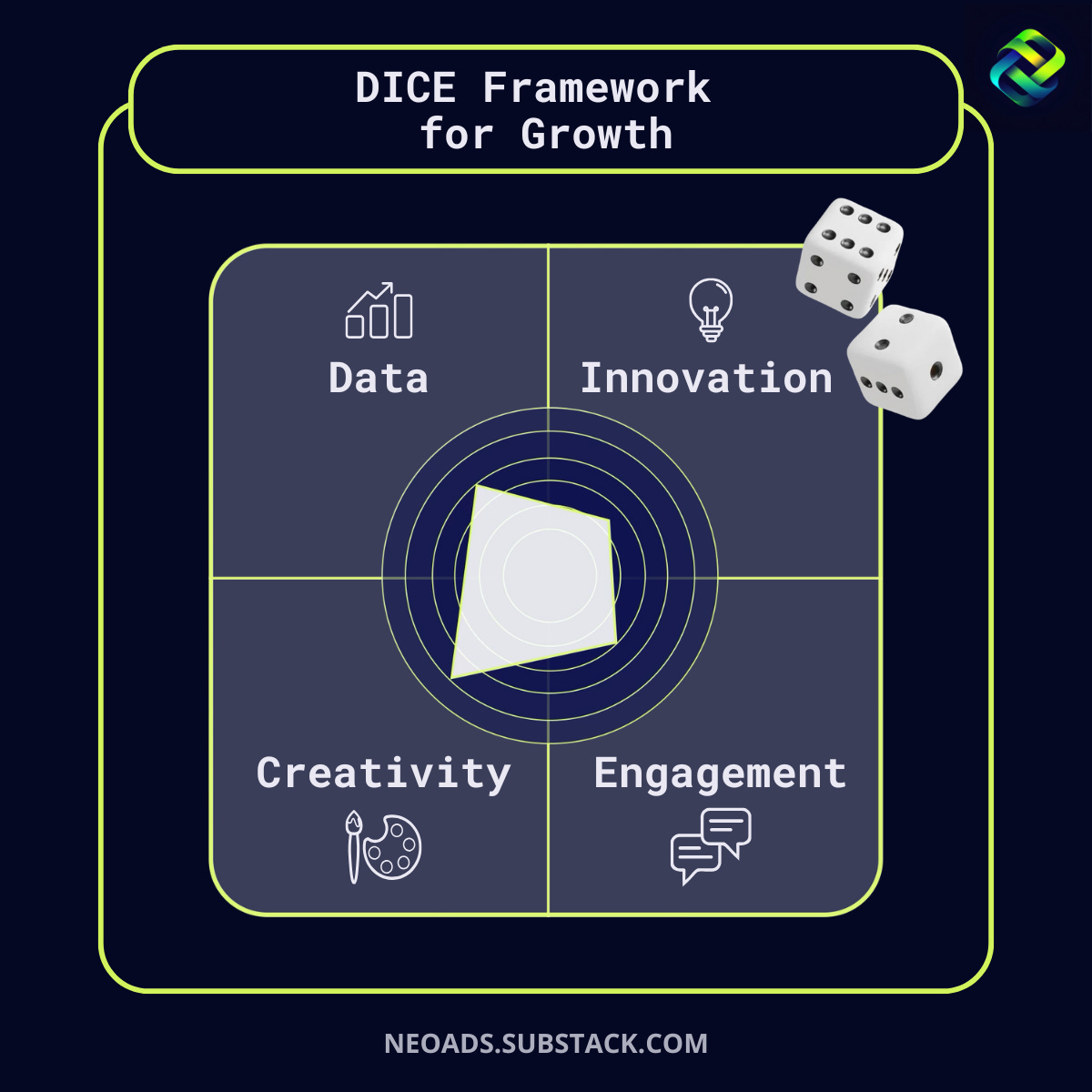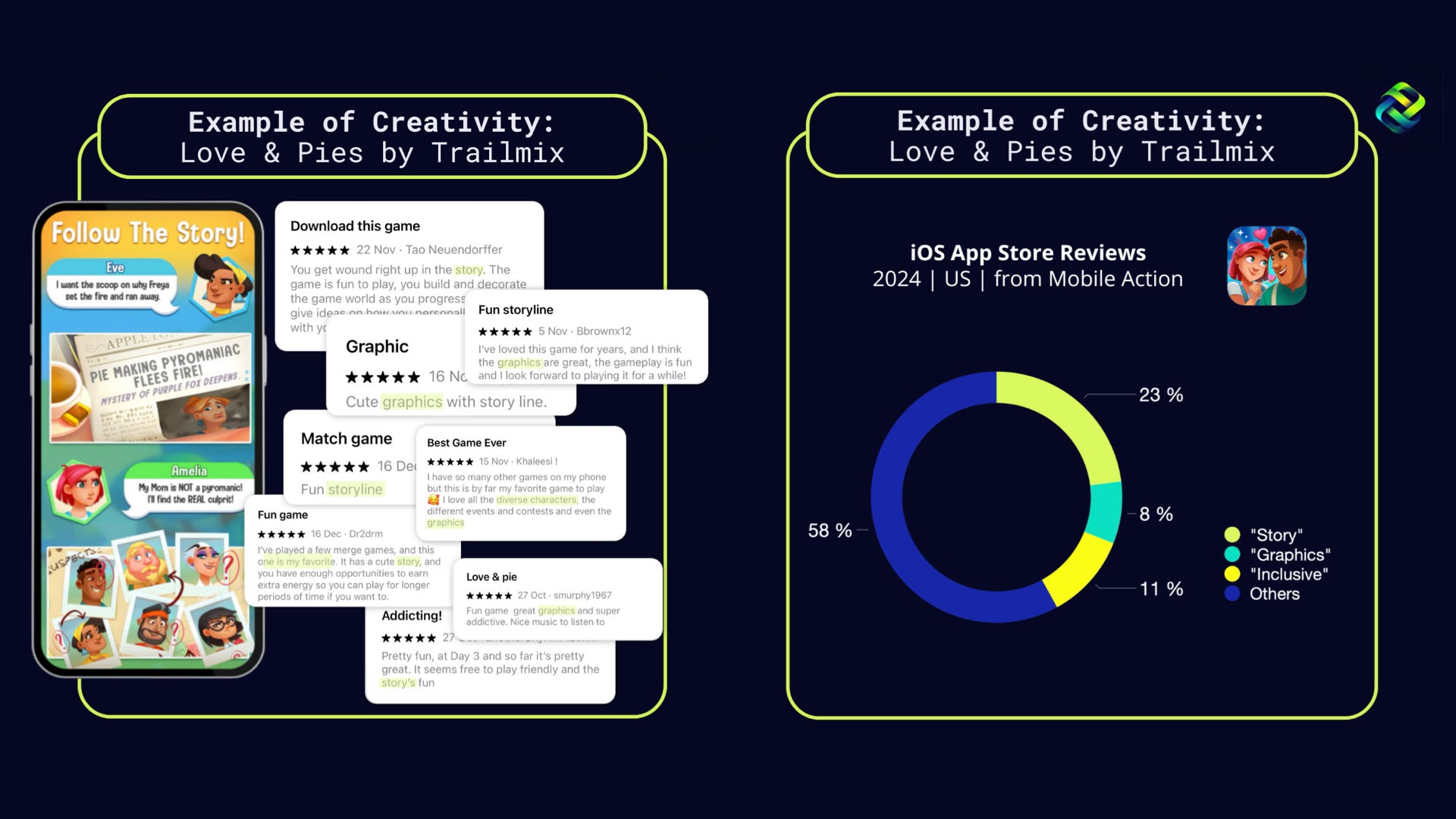
DICE Framework: AI, Data, and Creativity for Growth
Journal 31 Julie Tonna February 17
Last week, I had the opportunity to moderate a panel at Gamesforum in Barcelona about the state of user acquisition for free-to-play games. We discussed many topics, including the ever-increasing costs of acquiring new users, the constantly evolving landscape, and the reality of AI in marketing.

One topic that really stood out to me was how the role of the performance marketer is changing. Today, we are expected to cover many different areas, including creative optimizations, data analytics, long-term planning, and overall strategy.
From AI reducing the time spent on repetitive tasks and giving us some time back, to the challenges marketers face in standing out in an extremely competitive landscape with complex app store policies and ad network rules, we need to examine how this is evolving and how to prepare for the future.
The AI Wave
I’m currently reading The Coming Wave by Mustafa Suleyman, co-founder of DeepMind. In the book, he explores how AI and technology have been transforming our world and will continue to do so, progressively impacting all areas of our lives.
In Ad Tech, AI has been changing the industry for years. From programmatic advertising to automation & optimiser tools for campaign management and, more recently, generative AI supporting creative production, AI has grown exponentially each year. It helps UA managers automate repetitive tasks, allowing to focus on strategic decisions.
However, what at first seemed like a relief has actually added pressure.
Marketers are now expected to do more: be more creative, be more analytical, and be more innovative. While this shift may be exciting for some, the role now demands a highly diversified skill set, which can be difficult to develop without proper time and training.
The fast-changing landscape of Ad Tech
The Ad Tech industry is not for the faint-hearted.
Every week, new trends emerge in advertising:
- Changes in attribution models across different channels
- Privacy updates (hello Apple)
- Mergers and acquisitions reshaping the industry
- New players entering the market while others fade away
- Strategic partnerships and competitive rivalries
- Sophisticated tools constantly being released
To stay relevant, marketers must always be alert and up to date.
Keeping up can be overwhelming. Some companies support employee learning and growth. For freelancers, staying updated means actively reading newsletters, articles, attending industry events, and experimenting with new tools.
The new role(s) of Marketers
While discussing with fellow user acquisition managers and marketers, we all shared the same reality: the role has evolved significantly in recent years, requiring an ever-expanding set of skills.
There are different types of marketers:
- Data-driven marketers focus on analyzing vast amounts of data, drawing insights, and making strategic decisions.
- Innovative marketers constantly test new strategies, platforms, and tools.
- Creative marketers optimize key performance metrics such as click-through rates and conversions.
- Collaborative marketers work closely with product and monetization teams to enhance user engagement and retention.
While we all recognize these different profiles, the challenge is here: where should we focus our efforts, and how (or is it even possible) to excel at everything?
Introducing the DICE Framework
A few months ago, while reviewing top studios’ marketing strategies, I realized that there is no “one-size-fits-all” approach. Each team and product requires a tailored strategy. To address this, I developed a strategic framework that helps marketing teams identify their biggest strengths and maximize them to remain competitive.
The DICE framework can be visualized as a matrix with four key pillars:
- Data: metrics and processes guiding decisions.
- Do I have real-time dashboards tracking creative performance? How often do I run deep analysis of my campaigns? Should I move from a deterministic to a probabilistic approach, using Media Mix Modelling?
- Innovation: continuous testing and experimentation.
- Have I tested new ad format or channel in the past three months? Have I explored new geos, campaign types or ways of optimising my campaigns?
- Creativity: setting or following trends to optimize engagement.
- Do I experiment with new concepts and different creative lengths? Am I just following trends, or am I testing new ideas?
- Engagement: driving growth through team alignment and collaboration.
- Do I align UA with the ASO team? What about product and monetization Should we collaborate more and plan for the longer term?

The idea is to assess your marketing team’s core strengths, focus on scaling them, and then expand to other areas.
One great example of creativity in mobile gaming is Love & Pies: Merge Mystery by Trailmix. Released in September 2021, Love & Pies is a merge game that stood out by focusing on narrative, character development, and high-quality graphics.
By creating a rich and immersive gameplay, Trailmix differentiated from the competition in a highly saturated market. This strategy resonated with players, and the data supports it. Analyzing US App Store reviews at the end of 2024, around 42% of reviews included terms like “story,” “graphics,” or “inclusive.” This indicates that players weren’t just drawn in by standard merge mechanics but by the unique creative elements that set Love & Pies apart.
By looking at what your players enjoy about the game, using reviews for example, you can then use this information for your creatives in User Acquisition campaigns as well as your ASO strategy (or landing page).
Leveraging strong storytelling and distinctive creative assets can be a powerful driver of acquisition, growth, and retention.

There are various ways to determine these strengths and use them to plan for the next quarter, semester, or year. I’ll keep exploring this in greater detail in a future article with practical examples, tips, and tools.
So…what’s next?
I developed the DICE framework to provide a structured way to focus on, and maximize strengths while keeping sight of the bigger picture.
This industry is constantly shifting.
Whether due to rising acquisition costs, evolving privacy regulations, or new ad platforms, marketers can no longer rely on a single approach.
By leveraging Data, teams can make informed decisions that drive efficiency.
Through Innovation, they can stay ahead of trends and adapt to emerging challenges.
With Creativity, they can craft compelling campaigns that stand out in an oversaturated market.
And by focusing on Engagement, they can align efforts across UA, product, and monetization to build long-term, sustainable growth.
At the end of the day, the role of a performance marketer is no longer just about acquisition. It’s about strategy, adaptability, and collaboration.
The DICE framework provides a roadmap to navigate this complexity, ensuring that marketers can scale effectively without feeling overwhelmed.
As we continue to face new challenges in the ad tech and mobile marketing landscape, one thing remains clear: the ability to focus, iterate, and evolve will be the key to long-term success.







